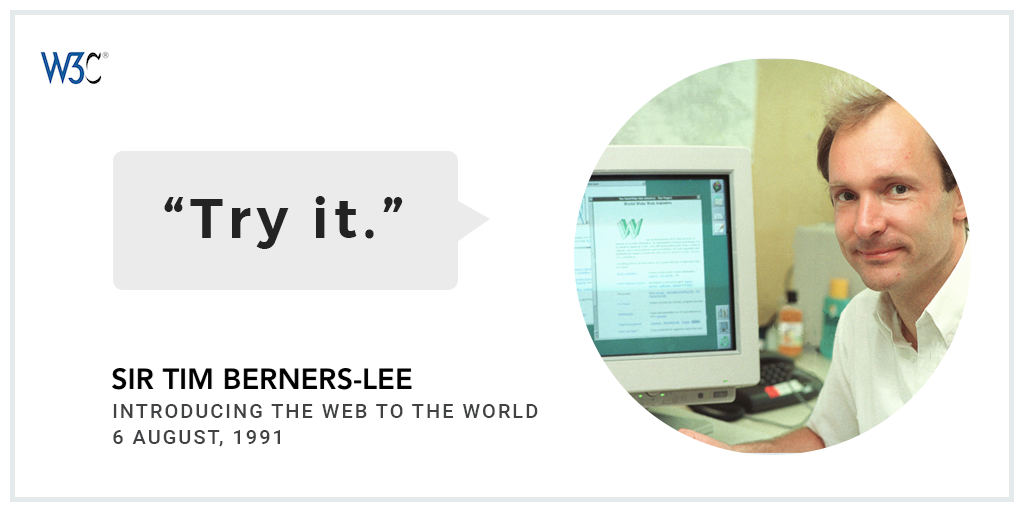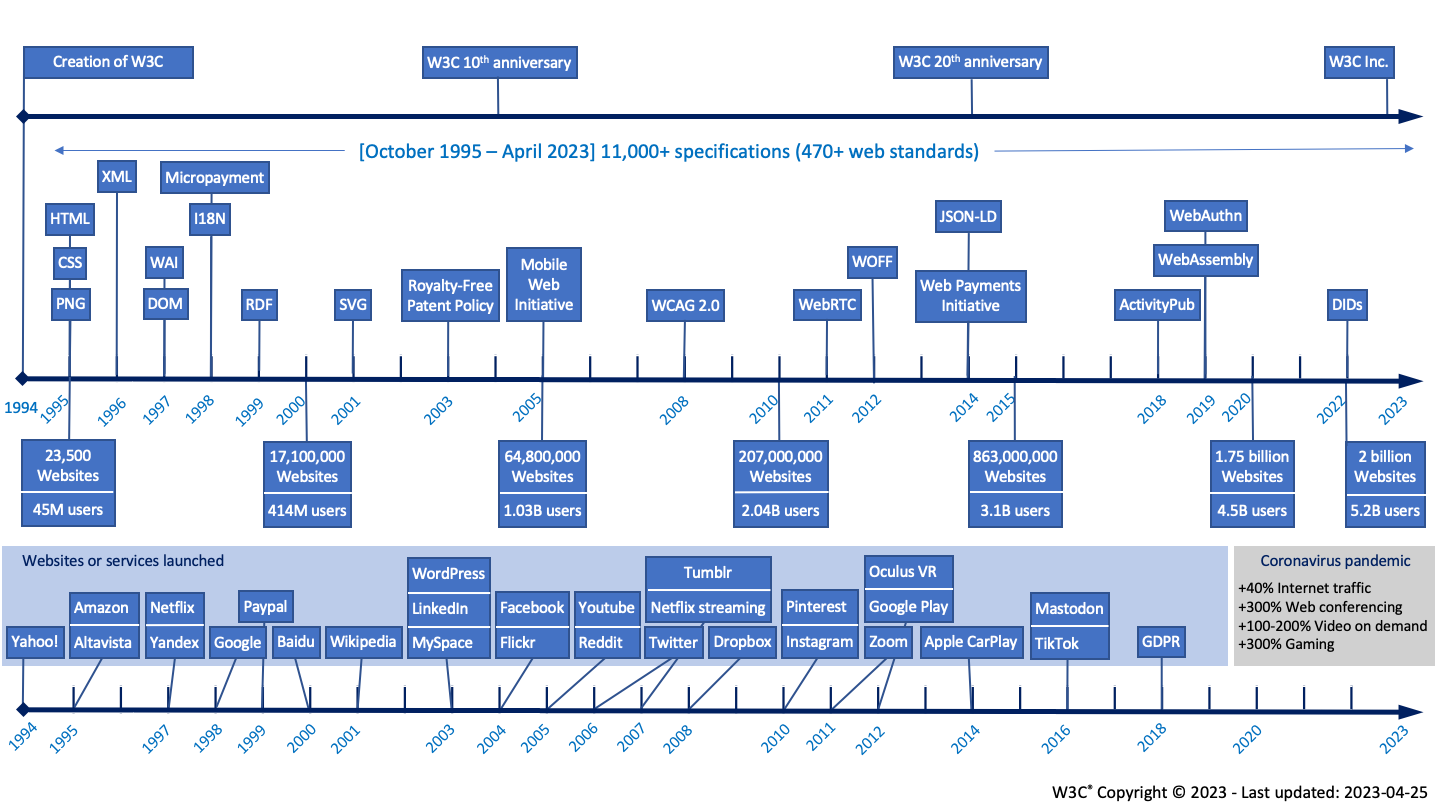30th anniversary of licensing the Web for general use and at no cost
本帖也有简体中文版本 (This post also exists in Simplified Chinese)
Today marks the 30th anniversary of the release of the World Wide Web into the public domain, for general use, and at no cost, on 30 April 1993 by CERN.
This quiet gesture, advocated by Web inventor Sir Tim Berners-Lee, has had implications beyond what he or anyone imagined at that time: the Web, free for everyone, has changed our lives.
Please, join me in taking a moment to appreciate the impact and the sheer magnitude of the revolution that started just two years prior. “Try it”, Sir Tim noted in his August 1991 email introducing the World Wide Web – and since then, billions of people have.

Two thirds of the world are online today (66% of the global population, or 5.3 billion people), and although access may vary greatly between parts of the world, there was a noticeable surge in the steady increase as a result of the Coronavirus pandemic, when suddenly people become reliant on the Web for communication, work, education, democracy, online shopping and business, connecting with family and friends, and entertainment, among myriad reasons to use the world’s truest social network.
The Web has been life-changing for people. I ran a short poll on social media a few weeks ago, asking people in what way(s) the Web changed their life. One response, of the many I got, stayed with me:
“I think there are two type of persons, the ones that the web changed their lives, and the ones that they are not aware that it changed their lives.”
It warmed my heart and reinforced the sense of purpose I get from working at W3C how people overwhelmingly and enthusiastically lauded the Web. Its positive impact can be broken into three main categories:
- Vital family and social interactions. Also, it’s astounding the number of people who met the love of their life thanks to the Web!
- Earning a living. Many found jobs as web developers, many conduct business online, many work from home thanks to the Internet and the Web.
- Empowerment and personal growth. From enabling people with disabilities or ill people to lead better lives, to breaking world frontiers and expanding horizons to learn, play and discover.
Sir Tim Berners-Lee founded the World Wide Web Consortium in 1994 as an international multi-stakeholder consortium to advance a consistent architecture accommodating progress in web standards, where member organizations, a full-time staff, and the public develop open web standards.
CERN’s decision to provide unencumbered access to the basic Web protocols and software developed there was instrumental to the success of the technical work done at the World Wide Web Consortium. The decision to base the Web on royalty-free standards from the beginning has been vital to its success. The open platform of royalty-free standards enabled software companies to profit by selling new products with powerful features, enabled e-commerce companies to profit from services that grew on this foundation, and brought social benefits in the non-commercial realm beyond simple economic valuation.
In May 2003, coinciding almost exactly with the tenth anniversary of CERN’s decision, W3C adopted a Patent Policy to enable continued innovation and widespread adoption of Web standards developed by the World Wide Web Consortium. The W3C Patent Policy governs the handling of patents in the process of producing Web Standards. The goal of this policy is to assure that Recommendations produced under this policy can be implemented on a Royalty-Free (RF) basis. By adopting this Patent Policy with its commitment to royalty-free standards, W3C laid the foundation for future decades of technical innovation, economic growth, and social advancement.
To date, W3C has published more than 11,000 specifications, of which 470 are web standards.
Among the many achievements originating from W3C that influenced the Web for the better, those that made it the premier information commons that it has become are:
- HTML, CSS, PNG (1995), the foundational technologies to display content on the web.
- XML (1996), enabling structured data on the web.
- Web Accessibility Initiative (WAI) (1997), for planning content and sites that are accessible to all, including disabled people.
- Patent Policy Working Group formed (1999), to reduce the threat of blocking patents on key components of Web infrastructure, and ultimately allow W3C to deliver royalty-free standards for the Web.
- DOM (1997), for giving logical structure allowing online documents to be accessed and manipulated.
- Internationalization (1998), for making the World Wide Web truly world-wide, adapted for people from any culture, region, or language, and ensuring text layout and typographic needs of scripts and languages around the world are built in Web technology.
- Ecommerce/Micropayment (1998), to make it possible to buy and sell goods and services online reliably and securely, and which led to a series of Web Payments work.
- RDF (1999), to model data interchange, and enable structured data to be mixed, exposed, and shared.
- SVG (2001), to enable two-dimensional graphics, allowing shapes, text and embedded graphics to be displayed on the web and integrated with HTML and CSS.
- W3C Patent Policy (2003), to assure that specifications can be implemented on a Royalty-Free (RF) basis and used at no cost, thus boosting adoption and usage.
- Mobile Web Initiative (2005), which made web access from a mobile device simple, easy, and convenient. As of August 2021, mobile devices accounted for 57% of web page views worldwide.
- W3C in China (2006), where the online presence has been leading for a long time, gave way notably to ongoing standardization of MiniApps to enhance the interoperability, accessibility, internationalization, privacy and security between different MiniApp platforms and the web.
- WCAG 2.0, to make content accessible to a wider range of people with disabilities, including blindness and low vision, deafness and hearing loss, learning disabilities, cognitive limitations, limited movement, speech disabilities, photo sensitivity and combinations of these. Following these guidelines often makes content more usable to users in general.
- WebRTC (2011), for bringing audio and video communications anywhere on the web, from any connected device.
- WOFF (2012), for providing downloadable fonts easily licensed and reliably used in any browser on laptops, mobile and TV. W3C received its third Technology & Engineering Emmy® Award in 2022 for standardizing font technology for custom downloadable fonts and typography for web and TV devices.
- JSON-LD (2014), for making Linked Data and RDF much easier to adopt by developers. Its most resounding success is its use in schema.org, allowing people to simply include machine readable data in their web pages, to help search engine better index them, and other web agents to better understand them.
- Web Payments (2014) for making web payments easier and more secure.
- ActivityPub (2018), for powering the world’s greatest decentralized network. The protocol enables creating, updating and deleting content across several federated servers.
- WebAssembly (2019), for enabling high-performance applications relying on a low-level infrastructure, and enhancing web performance and power consumption.
- WebAuthn (2019), for making the web more secure and usable, by building support for easy and secure logins via biometrics, mobile devices and other implements.
- DIDs (2022), to empower everyone on the web with privacy-respecting online identity and consent-based data sharing.
Our vision for the future is a Web that is truly a force for good. A World Wide Web that is international and inclusive, respectful of its users. A Web that supports truth better than falsehood, people more than profits, humanity rather than hate. A Web that works for everyone, because of everyone.

Thank you, Sir Tim, and everyone who worked for and with the W3C. Your work has changed countless lives!
It is only fair to mention that the release of WWW technology into the public domain in 1993 was, to my personal knowledge, also strongly advocated by TimBL's close colleague Robert Cailliau. It should also be credited to CERN's founding convention signed in 1953, which requires that "the results of its experimental and theoretical work shall be published or otherwise made generally available."
Thank you for this timeline and web appreciation article, Coralie.
The web certainly changed my life and career, beginning in 1993.
It's incredible to look back and appreciate how far we've come with web tech in so short a time.
Thanks for all the vital standards work, W3C and friends. I hope you're all celebrating too.